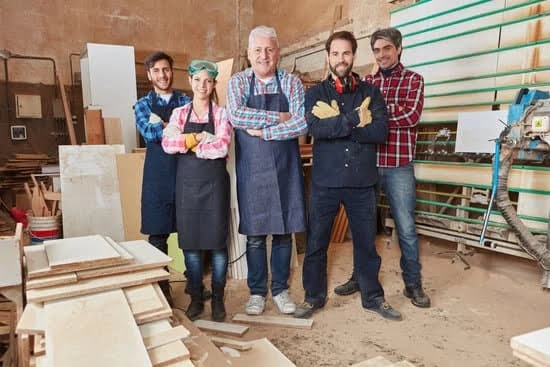Woodworkers have a unique way of referring to the structural framework of their creations – they call them carcasses. But why do woodworkers use this term? In the world of woodworking, the term “carcass” holds a significant place in describing the underlying structure and framework of furniture and other wooden creations. From its origins to its modern applications, understanding the concept of “carcass” is essential for any woodworking enthusiast.
The use of the term “carcass” in woodworking has historical roots that date back centuries, when craftsmanship and attention to detail were highly esteemed. Today, this term still carries on this tradition by emphasizing the importance of precision and strong foundational structure in woodworking projects.
In traditional woodworking, “carcass” refers to the internal supporting framework that gives stability and shape to furniture pieces. It is a fundamental aspect of woodworking, serving both functional and aesthetic purposes. Understanding why woodworkers call things carcasses allows us to appreciate the thought and skill put into creating these foundational structures that ultimately bring beauty and functionality to wooden creations.
Understanding the Importance of Structure in Woodworking
The term “carcass” may sound unfamiliar to those outside the woodworking community, but it holds significant importance in the craft. In woodworking, the term “carcass” refers to the basic framework or structure of a piece of furniture or cabinetry before any decorative elements are added. This foundational element is crucial in providing stability and support to the final product.
Woodworkers call these structures carcasses because they form the essential skeleton of the finished piece, much like the bones of a living creature. The use of this term dates back to traditional woodworking practices, where craftsmen would meticulously construct these frameworks with precision and care.
The significance of understanding the importance of structure in woodworking cannot be overstated. The quality and durability of a woodworking project greatly depend on a strong and well-constructed carcass. Without a solid foundation, the final product may lack stability and longevity. Additionally, understanding how to build and assemble carcasses allows woodworkers to explore a wide range of design possibilities while ensuring structural integrity.
Exploring the Use of the Term Carcass in Traditional Woodworking
The term “carcass” in woodworking has its origins in traditional woodworking practices, where the structure and framework of a piece were often referred to as the carcass. This term can be traced back to early European woodworking traditions, where craftsmen used it to describe the inner framework of a piece of furniture or cabinetry.
The use of this term underscores the importance of structure and foundational elements in woodworking, emphasizing the role that these components play in creating a sturdy and durable final product.
Functional and Aesthetic Significance
In traditional woodworking, the carcass serves both functional and aesthetic purposes. From a functional standpoint, the carcass provides the foundational support for the entire piece, ensuring its stability and durability. Additionally, it determines the overall shape and dimensions of the finished product. On an aesthetic level, the construction of a solid carcass sets the stage for adding decorative elements and finishes that enhance the visual appeal of the final piece.
The Craftsmanship Behind Carcasses
Crafting a well-built carcass requires precision, attention to detail, and an understanding of structural integrity. Every joint must be carefully constructed to ensure a tight fit, contributing to the overall strength of the piece. Woodworkers often spend significant time and effort refining their techniques for building and assembling carcasses, recognizing their pivotal role in creating high-quality finished products.
Understanding why woodworkers call things carcasses provides insight into traditional woodworking methods and emphasizes the fundamental importance of structure in crafting wooden pieces. Whether constructing furniture or cabinetry, mastering carpentry techniques related to building sturdy carcasses is essential for creating long-lasting and visually appealing woodwork projects.
The Functional and Aesthetic Purpose of Carcasses in Woodworking
In traditional woodworking, the term “carcass” refers to the framework or basic structure of a piece of furniture. Woodworkers call things carcasses because it embodies the skeletal framework that provides support and shape to the final product. This essential component serves as the foundation upon which other elements such as doors, drawers, and decorative features are added. Understanding the functional and aesthetic purpose of carcasses in woodworking is crucial for creating durable and visually appealing pieces.
Functional Purpose of Carcasses
The primary function of a carcass in woodworking is to provide structural stability to a piece of furniture. It determines the overall shape, size, and strength of the end product. Additionally, carcasses play a vital role in distributing weight and supporting any additional components such as shelves or drawers. Without a well-constructed carcass, furniture would lack durability and longevity.
Aesthetic Purpose of Carcasses
Aside from its functional significance, carcasses also contribute to the visual appeal of woodworking projects. The style and design of the carcass greatly influence the overall look of the finished piece.
For example, a solid wood carcass with clean lines may convey a sense of timeless elegance, while a more intricate design with ornate details can exude a sense of grandeur. In this way, woodworkers use carcasses not only for their structural integrity but also as a means to express creativity and artistry in their craft.
Enhancing Versatility
Furthermore, carpenters recognize that well-constructed carcasses can enhance versatility in woodworking projects. A thoughtfully designed carcass can accommodate different types of finishes, hardware, or modifications without sacrificing its stability or functionality. This adaptability allows woodworkers to create custom pieces tailored to specific needs or preferences while maintaining quality craftsmanship. Hence, understanding how carcasses serve both functional and aesthetic purposes is fundamental for any woodworker seeking to excel in their craft.
Why Precision and Detail Matter in Crafting Carcasses
In woodworking, the term “carcass” refers to the basic framework or structure of a piece of furniture. It is essentially the skeleton on which the final piece will be built. But why do woodworkers call things carcasses? The term “carcass” actually has its origins in the French word “carcasse,” which means frame or structure. This term has been adopted by woodworkers to describe the foundational element of their projects.
Precision and attention to detail are essential in crafting carcasses in woodworking. The accuracy of measurements and cuts directly impacts the stability and overall quality of the finished piece. Here are some reasons why precision and detail matter when crafting carcasses:
- Structural Integrity: Ensuring that the carcass is constructed with precise measurements and tight joints will result in a sturdy and durable piece of furniture.
- Aesthetic Appeal: A well-crafted carcass provides a solid foundation for adding decorative elements and finishes, enhancing the overall appearance of the final product.
- Professionalism: Woodworkers take pride in their craftsmanship, and attention to detail sets their work apart as high-quality and professional.
Achieving precision and detail in crafting carcasses requires careful planning, accurate measuring, and skilled execution. Without these elements, the structural integrity and visual appeal of a woodworking project may be compromised. The next time you admire a beautifully crafted piece of furniture, consider the level of precision and detail that went into constructing its carcass.
Techniques for Building and Assembling Carcasses
In the world of woodworking, the term “carcass” is used to refer to the basic structure or framework of a piece of furniture. While the word “carcass” may conjure up images of animal remains, in woodworking, it simply refers to the internal structure of a piece, before any decorative elements or finishing touches are added.
So why do woodworkers call things carcasses? Let’s delve into some techniques for building and assembling carcasses to understand the importance and intricacies of this term in traditional woodworking.
1. Selecting the Right Wood: Choosing the right type of wood for building a carcass is crucial. Typically, hardwoods such as oak, maple, or cherry are used for their durability and strength. Softwoods like pine can also be used for certain projects where a lighter frame is desired.
2. Joinery Techniques: Joinery refers to the way pieces of wood are connected to form a strong and sturdy bond. Popular joinery techniques for building carcasses include dovetail joints, mortise and tenon joints, and biscuit joints.
3. Assembly Methods: Assembling a carcass requires precision and attention to detail to ensure that all components fit together seamlessly. This often involves using clamps, glue, and sometimes even specialized tools like pocket hole jigs to create secure connections.
These techniques for building and assembling carcasses are fundamental to creating well-constructed pieces of furniture in traditional woodworking. The use of quality materials, skilled joinery techniques, and meticulous assembly methods ensures that the resulting carcass is not only structurally sound but also serves as a strong foundation for adding decorative elements and finishing touches later on in the woodworking process.
The Evolution of Carcass Construction in Modern Woodworking
The term “carcass” in woodworking has ancient origins that date back to traditional carpentry and joinery practices. Historically, the term refers to the internal framework or structure of a piece of furniture, such as a cabinet or chest of drawers. In modern woodworking, the concept of carcass construction has evolved to include a wider range of techniques and materials, reflecting advancements in technology and design trends.
One reason why woodworkers call things carcasses is to emphasize the structural integrity and foundational support provided by these components in woodworking projects. Carcasses serve as the backbone of furniture pieces, determining their strength, stability, and overall functionality. In modern woodworking, the construction of carcasses involves precise measurements, joinery methods, and attention to detail to ensure that the resulting pieces are durable and long-lasting.
With the advent of new tools and equipment, as well as innovative approaches to design, modern woodworkers have expanded the possibilities for carcass construction. While traditional techniques such as mortise-and-tenon joints and dovetail joints are still valued for their strength and longevity, contemporary methods like pocket hole joinery and biscuit joinery offer efficiency and versatility in assembling carcasses. Additionally, the use of engineered wood products provides alternative options for constructing lightweight yet sturdy carcasses.
| Woodworking Evolution | Modern Carcass Construction |
|---|---|
| Ancient origins | New tools & equipment |
| Precise measurements | Innovative joint techniques |
| Traditional craftsmanship | Balance with innovation |
Common Misconceptions About the Term Carcass in Woodworking
Woodworkers often use the term “carcass” to refer to the basic framework or structure of a piece of furniture. This term may seem a bit unusual, and one might wonder why woodworkers would choose to call things carcasses.
The origins of this term in woodworking can be traced back to traditional French and Latin languages, where “carcasse” referred to a framework or support structure. In woodworking, the carcass provides the essential foundation for building furniture, offering stability and support for the overall design.
One common misconception about the term “carcass” in woodworking is that it may carry negative connotations due to its association with animal remains. However, in the context of woodworking, “carcass” simply refers to the internal framework or skeleton of a piece of furniture. It is not meant to evoke morbid imagery, but rather to emphasize the importance of structural integrity and support in woodworking projects.
Another misconception is that the term “carcass” only applies to traditional furniture styles or construction methods. In reality, carcasses are an essential component of both traditional and modern woodworking practices. Whether it’s a classic cabinet or a contemporary modular shelving unit, the concept of a carcass remains integral to creating functional and visually appealing furniture pieces.
Understanding the true meaning and significance of the term “carcass” in woodworking can help individuals appreciate the structural intricacies involved in creating quality pieces. By recognizing its historical roots and practical application, woodworkers can develop a deeper understanding of how carcasses form the backbone of well-crafted furniture.
The Versatility and Adaptability of Carcasses in Different Woodworking Projects
Woodworkers call things carcasses because the term has its origins in traditional woodworking practices. The term “carcass” comes from the French word “carcasse,” which means “the frame or main structure of a piece of furniture.” In woodworking, the carcass refers to the basic framework or structure of a piece, such as a cabinet, dresser, or table. Woodworkers use this term to refer to the internal framework before adding finer details and finishes.
Understanding the importance of structure in woodworking is key to comprehending why woodworkers call things carcasses. The carcass serves as the foundation for a woodworking project, providing it with stability and strength. Additionally, the carcass determines the overall shape and dimensions of the piece being constructed. Without a well-built and sturdy carcass, a woodworking project would lack structural integrity and durability.
The adaptability and versatility of carcasses in different woodworking projects make them an essential element in traditional and modern woodworking. Carcasses can be tailored to suit various design styles and functions, whether it’s for minimalist Scandinavian furniture or ornate Victorian pieces.
The ability to modify and customize carcasses allows woodworkers to create pieces that meet specific aesthetic and functional requirements. Whether it’s a simple box-style frame for a bookshelf or a complex interlocking structure for a wall unit, carcasses play a crucial role in bringing woodworking projects to life.
Examples of Stunning Carcass Designs in Woodworking
In conclusion, the term “carcass” has a long history in woodworking and refers to the basic framework or structure of a piece of furniture. The origin of the term can be traced back to traditional woodworking practices where precision and attention to detail were essential. The carcass serves both functional and aesthetic purposes, providing stability and support while also contributing to the overall design of the piece.
Woodworkers call things carcasses because it accurately describes the foundational structure of their creations. Whether it’s a cabinet, desk, or bookshelf, the carcass provides the essential framework upon which additional components are added. This term has been used for centuries and continues to be a fundamental concept in woodworking.
From traditional techniques to modern innovations, woodworkers have developed various methods for crafting and assembling carcasses. Precision and detail are crucial in ensuring that the carcass is strong, durable, and visually appealing. Additionally, the versatility of carcasses allows woodworkers to adapt them to different projects and design requirements, showcasing stunning examples of craftsmanship in woodworking. Overall, understanding the significance of carcasses in woodworking sheds light on the intricate artistry and skill involved in creating beautiful and functional pieces of furniture.
Frequently Asked Questions
What Is a Carcass in Woodworking?
In woodworking, a carcass refers to the main framework or structure of a piece of furniture, such as a cabinet or a chest of drawers. It’s essentially the skeleton of the furniture item and provides stability and support for the overall piece.
What Does Carcass Mean for a Kitchen?
In the context of a kitchen, a carcass typically refers to the basic structure or framework of kitchen cabinets. This includes the outer shell of the cabinets, including panels, shelves, and drawers. The carcass provides the foundation for the doors, drawers, and other visible elements in a kitchen design.
What Is a Carcass in Furniture?
When it comes to furniture, a carcass is essentially the supporting structure that forms the foundation of a piece. This may include side panels, back panels, shelves, and other internal components that provide strength and stability to the overall piece of furniture.
The carcass is usually hidden from view once the furniture is fully assembled and upholstered or finished on its exterior.

Hi everyone! I’m a woodworker and blogger, and this is my woodworking blog. In my blog, I share tips and tricks for woodworkers of all skill levels, as well as project ideas that you can try yourself.





